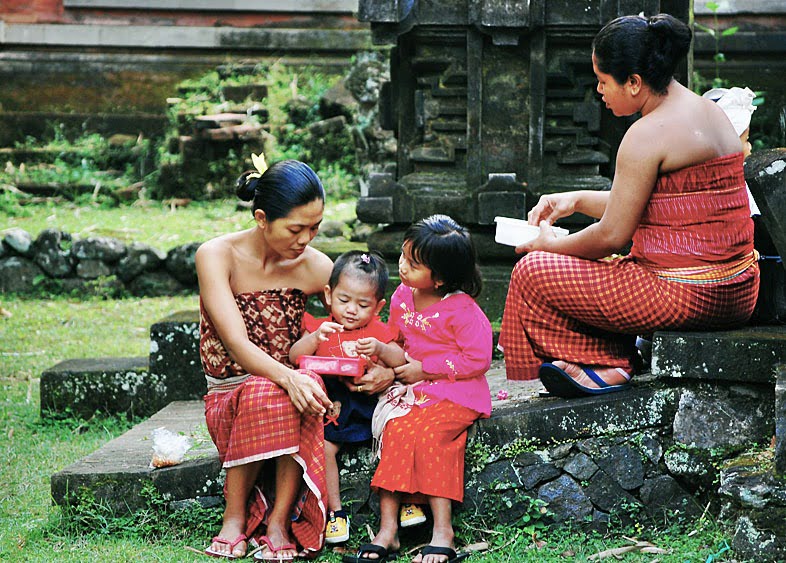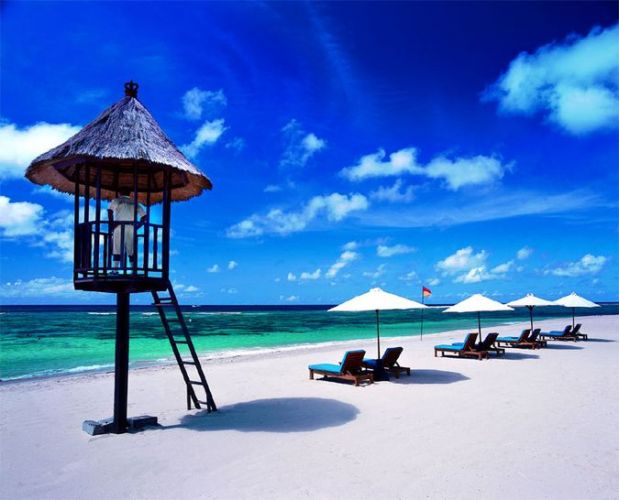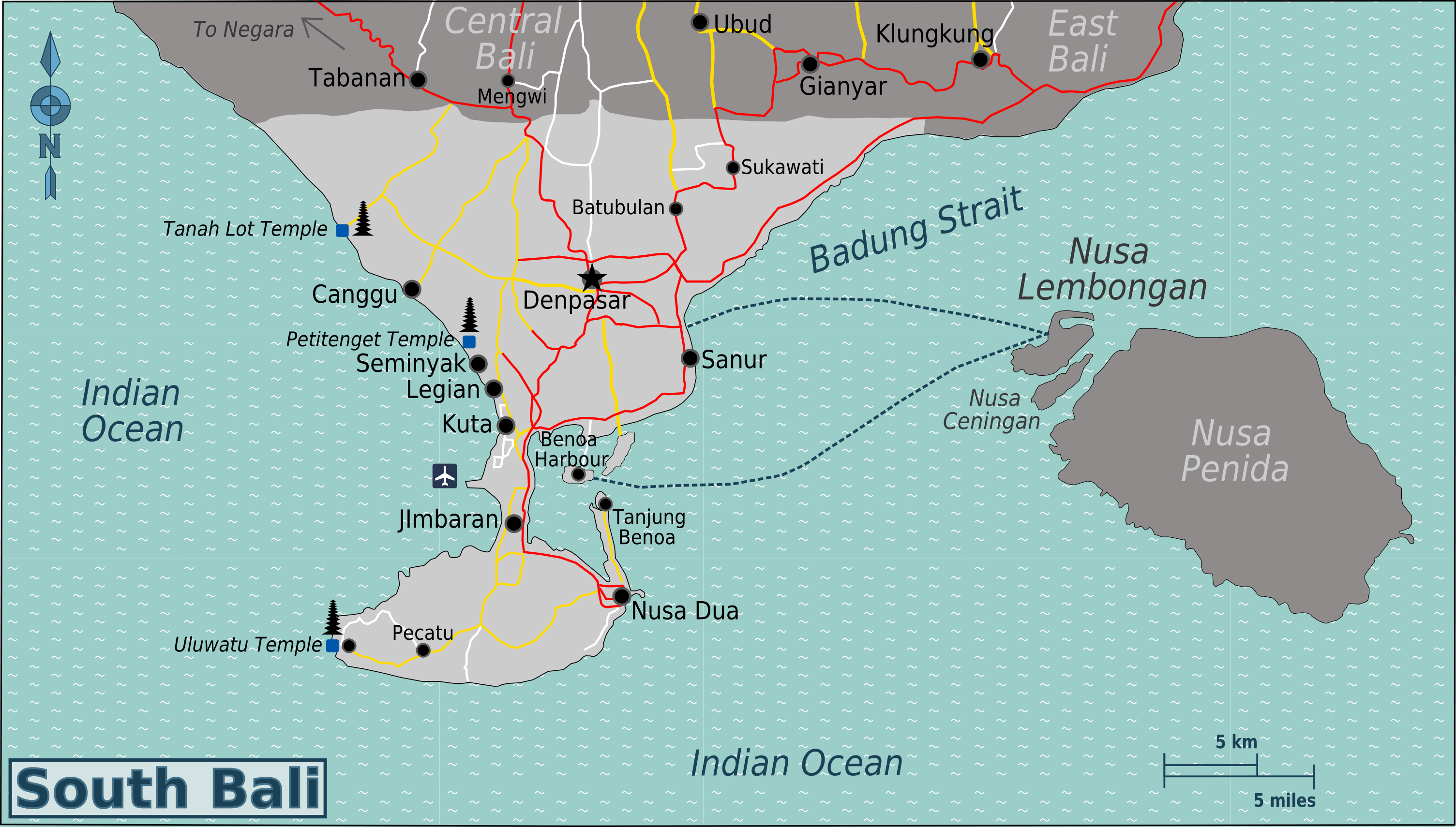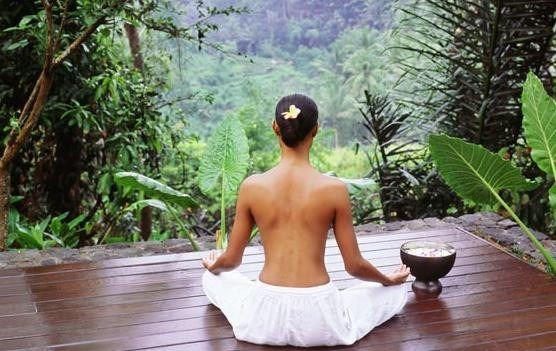
Say Bali and most people think paradise. The island boasts stunning sunsets, sculpted rice terraces, temples on every corner, and an enthralling landscape full of lush jungles and blissful beaches.

But the true beauty of this world-renowned island lies in the fact that Bali is an island paradise with many different faces.
Bali has a tendency to attract a wide range of travelers seeking a variety of experiences – the wonderful thing is that Bali offers something for everyone. The island is a surfer’s paradise and you can spend a few blissful weeks here on an oceanfront villa watching the waves roll in when you’re not riding them. But it could also be the spiritual seeker’s paradise, a beautiful island retreat on which to practice yoga and meditation in solitude while feasting on a diet of raw fruits and veggies.

For some, Bali is a perpetual party in paradise. Spring breakers and party goers will find a treasure trove of wild nights to be had near or on the island’s beautiful beaches. But this same party island also offers romance and serenity for honeymoon couples looking to get away from it all as well as family-friendly fun and accommodations for parents with children.
A truly versatile paradise, there are many different Balis depending on who you are and what you’re seeking. Peruse through the area guide below to see which Bali jibes with you!
Check out this post for more Bali information and travel tips.
South Bali
South Bali is by far the most visited part of the island and the majority of the tourism industry is focused here. The infamous Kuta Beach is the most popular destination in southern Bali and draws huge crowds of mostly party-seeking tourists.

Southern Bali is the spot you head to find low-to-middle budget accommodations, hordes of cafes and restaurants bustling with people, crowds of young tourists rushing to and from bars and beaches, and shops galore.
Although generally popular with tourists, all of south Bali is not the same.

Kuta:
The most well-known area in Bali, Kuta has been a popular stop on the classic backpacking route in Southeast Asia since the 80s. Originally discovered as a surfing paradise, Kuta’s long and broad Indian Ocean beach front still attracts some surfers but its visitors today are mostly young travelers from Australia in Kuta for its notorious party scene.

Kuta’s five-kilometer-long sandy beach is arguably the best beachfront in Bali, but it also tends to be full of sunbathers as well as beach vendors pushing massages, souvenirs, hair braiding, etc. This is undoubtedly Kuta’s biggest drawback – it is very touristy. The entire Kuta Beach area is full of often aggressive street hawkers and touts and loud tourists. That being said, Kuta’s biggest drawback is also its greatest advantage – the development of the tourism industry means a huge range of budget accommodations as well as a fantastic range of restaurants and shops.
Legian:
Located halfway between Kuta and Seminyak, Legian is a beachfront town that functions as a sort of “quieter Kuta.” Close to the touristy Kuta, Legian offers the same easy access to shops, bars, and nightlife but in a more relaxed and less chaotic setting. You can still find the low prices of Kuta here without most of the hassle, making Legian an increasingly popular place with travelers who want to party, shop, and mingle – without living in the middle of the hustle and bustle.
Seminyak:
As you move north from Kuta to Legian and then to Seminyak, it becomes progressively quieter and less frenetic. Seminyak is yet another beach town in south Bali but it distinguishes itself with more upmarket, luxury accommodations and high-end restaurants, bars, and shops.

The atmosphere is distinctly more sophisticated and laid-back than Kuta, making it a popular choice for the gliterrati wanting to hit up the swanky establishments in the area, honeymoon couples who prefer the solace within close proximity to the hustle and bustle, shoppers looking to peruse the high-end spas and boutique shops of Seminyak, as well as the more upscale party crowd.
Jimbaran:
To the south of Kuta lies Jimbaran, home to several world-class 5-star beach resorts and high-end villas that have resulted in Jimbaran acquiring nicknames such as the “Beverly Hills of Bali” or “Millionaire’s Row.” Unlike its neighbor, Kuta, Jimbaran offers very little in the way of budget accommodations, although you can find a few moderate, mid-market hotels here.

Jimbaran has a lovely white sand beach that’s safe for swimming as well as some great seafood restaurants on the beach that are ideal spots to enjoy stunning sunsets while grilling delectably fresh seafood. There is pretty much no night life here, but it has the advantage of being close to Kuta and Seminyak for when you want to pain the town red.
Bukit Peninsula:
The Bukit Peninsula is the southernmost point of Bali and covers the area south of Jimbaran and west of Nusa Dua. Also originally popularized by surfers, the Bukit remains one of Bali’s top surfing spots with numerous small, cheap bugalows close to the main surf points at Uluwatu, Padang-Padang, Bingin, and Suluban.

An area with some of the most beautiful beaches on Bali – including Balangan Beach – and the famous cliff-hanging temple at Uluwatu, the Bukit Peninsula is a very popular tourist destination in Bali and has recently seen massive development in the form of high-end villas and resorts.
It’s decidedly more quiet than the more popular tourist areas to the north – Kuta and Seminyak – but is close enough (30-minute cab ride to Kuta Beach) for travelers who’d prefer to stay near beautiful, less-crowded beaches but be within reasonable distance to shopping and nightlife.
Nusa Dua:
A peninsula in South Bali that is well-known as a high-end tourist enclave, Nusa Dua is a very safe, very clean area with a host of luxury hotels, the most popular golf course on the island, one of the best museums in Bali, and pristine, barely populated and well-maintained beaches with calm waters perfect for swimming.

The Nusa Dua area is mostly only accessible to the guests of the luxury hotels and with three manned gates, everyone who enters the enclave is subject to a security search. As such, Nusa Dua tends to attract families with children and individuals concerned for safety after the terrorist incidents of 2002 and 2005.
Sanur:
North of Nusa Dua and east of Kuta, Sanur is Bali’s oldest upscale resort area and a mature beach-side town. Although close to Kuta, Sanur has an entirely different feel – more quiet and relaxed – and it tends to appeal mostly to middle-aged and older families.
Similar to Kuta, Sanur has an abundance of restaurants and accommodation. Prices tend to be more expensive than Kuta but cheaper than Seminyak.
Central Bali
The central part of the island is also the cultural heart of Bali. Although less than an hour’s drive from the party town of Kuta, central Bali offers an entirely different world for travelers.
Ubud:
A town in central Bali that offers a thriving tourist scene that is far, far removed from the drunken bikini scene in Kuta. The name of the tourism game here is culture and visitors will find plenty of traditional Bali culture here with dance shows, concerts, and kecak fire shows presented every night of the week. Ubud is also a famous arts and crafts hub and with plentiful artists’ workshops and galleries, you’ll find amazing examples of Balinese art and handicrafts around the shops of Ubud.

As the part of Bali where “Eat, Pray, Love” was filmed, Ubud has garnered a new reputation as a sort of spiritual center. Travelers can now seek solace in newly-built yoga and mediation retreats set amidst the iconic images of Bali’s lush rice terraces and beautiful Hindu temples.

Bedugul:
This lovely area covering the central highlands of Bali is the go-to place for nature lovers. The focal point of the area centers around the three crater lakes of Bratan, Buyan, and Tamblingan as well as the nearby botanical gardens.
With mountains to hike and bike, the most photographed temple on the island, impressive waterfalls to explore, beautifully manicured botanical gardens, and lush green rice terraces so spectacular they were nominated as a UNESCO World Heritage Site, the Bedugul area is sought by travelers for its pristine natural beauty.

Situated in the mountain range of central Bali, it tends to be chilly here so prepare to dress accordingly during your stay here.
North Bali
The coastal area of north Bali is so far removed from the hectic pace of south Bali, it almost seems like a different island. In Dutch colonial days, north Bali was home to the capital of the island (the town of Singaraja) and touches of that history still remain today with the noticeably wide boulevards and the occasional old house that’s managed to retain the large gardens typical of Dutch architecture.
That atmosphere of the old capital city combined with the quiet black sand beaches of north Bali gives it a feel different from any other part of the island.
Lovina:
This is the place you come to get away from it all – Lovina offers a whole stretch of coast fringed by quiet black sand beaches ideal for swimming, diving, snorkeling, and dolphin watching. The slow, traditional pace of life in the quiet town of Lovina offers a glimpse into Balinese life that is hard to find elsewhere on this bustling tourism-driven island.

Still, not all is quiet reflection in Lovina – the area boasts an abundance of cafes providing loud, live music and a vibrant night-life that is a world apart from the rowdy, ready-to-party crowds of Kuta.
East Bali
East Bali offers a pleasant break from the busy tourist crowds of the south and central Bali – most of the tourist trails on the eastern coast of Bali are pleasantly spared from huge crowds although, with the completion of new roads from south Bali, it won’t be like this for long.
The eastern coast is popular with nature lovers and travelers more interested in sight-seeing and exploration than lying on the beach. There’s plenty to discover in these parts: rainforests, rice terraces, mountains, upland plains, active volcanoes, spectacular diving spots, and ornate temples. The major attractions are the majestic Mount Agung volcano and the Besakih temple, known as the Mother Temple of Bali and the most important temple on the entirety of the island. These sights can be seen while staying on the relaxed coastal towns of East Bali.

Of course, you don’t have to miss out on the beach lazing here, too – there are beautiful volcanic-sand beaches to indulge on. Not to mention the popular seaside resort towns of southeastern Bali and the ferries you can catch to the paradise beaches of the Gili Islands and Lombok from here. (read more about Gili Islands Bali).
East Bali is a pretty large region and there are a few lovely places you can stay while you’re here:
Amed:
Amed is a long coastal strip of fishing villages with stunning scenery and black volcanic sand beaches, some with beautiful views of Mount Agung, Bali’s highest volcano.

The area is the most recent tourist development in Bali and as such, the pace of life here remains peaceful and slow. It’s the perfect place to experience the life of the local Balinese who make a living from fishing and salt-making. As for tourists, the majority of travelers here are divers looking to dive the USS Liberty wreck at nearby Tulamben, as well as a number of awesome dive spots nearby.
Amed is also a preferred base of people looking to visit or climb nearby Mount Agung.
Candidasa:
A beautiful stretch of coastline with a laid-back and relaxing feel, Candidasa is quickly becoming an east Bali favorite. More and more visitors show up in town for the tranquil atmosphere and easy access to nearby sights such as the mighty Mount Agung and the most famous Bali Aga (original Balinese) village.

Candidasa is not much for beaches but it is situated at the center of all the famous dive sites of Bali, making it a must-visit for divers.
Tirta Gangga:
Tirta Gangga literally means “water from the Ganges” and this little village in East Bali is a revered site for the Hindu Balinese. Located just 20 minutes from the more popular coastal towns of Candidasa and Amed, this lovely village is home to some of the best trekking in Bali, absolutely stunning rural landscapes full of picturesque rice terraces, and the Tirta Gangga water palace, a lovely maze of pools and fountains surround by a lush garden and stone carvings and statues.

The accommodations here are mostly budget and backpacker-oriented, but you can stay at a more upscale resort at Candidasa, which is only about 20 minutes away.
Padang Bai:
Most travelers only know of Padang Bai as the place to catch a boat to the Gili Islands or Lombok, but few suspect that this charming little place offers much in its own right.

It’s a small town with a backpacker feel to it – intimate and relaxed, with everything close enough to explore on foot. The town holds a few beautiful beaches with great snorkeling, some temples to enjoy, and fresh seafood that’s worth staying a few days to enjoy before heading off for the more popular waters of Gili and Lombok.
West Bali
The westernmost reaches of Bali is the least populated and least visited region of the entire island. The majority of west Bali is dominated by the West Bali National Park and a huge area of the protected reserve, most of which is completely uninhabited.
Much like the rest of the beautiful island, there are beaches in the western region but they are of a very different nature than the ones you’ll find on the popular southern parts of the island. The seas off West Bali’s northern coast offers excellent diving and snorkeling and the waters off West Bali’s southern coast are wilder, making them popular with intrepid surfers.
Pemutaran:
A small fishing village on the northwestern coast of Bali, this laid-back town is becoming increasingly popular with visitors. It’s in close proximity to Lovina (see above, under North Bali) as well as West Bali National Park which contributes to its popularity, but a huge draw of Pemutaran is simply the beauty of the village itself.
Pemutaran is home to the largest artificial Biorock reef project in the world and there is a real spirit of marine conservation in this area, drawing underwater enthusiasts from around the world.

The Pemuteran Bay also has the largest area of shallow reefs in Bali and without the strong currents and waves that characterize other coastal areas of Bali, it’s the ideal spot for snorkelers and divers to relax and enjoy a few awesome underwater spots such as the Temple Garden where you can explore an underwater temple with statues of Buddha and Ganesha covered in cleaning shrimps.
Medewi:
This is a tiny, remote village in one of the least visited area of Bali. As a surfing hotspot, it’s sought by surfers from far and wide and most travelers you’ll find here are die-hard surfers who are here for that reason and that reason alone.

For non-surfers, Medewi offers a glimpse into what Bali was like before the growth of mass tourism in the 1970s and is a wonderful place to relax away from it all.
West Bali National Park:
As the only national park on the entire island of Bali, the West Bali National Park is definitely worth a visit. It’s located at the most north-westerly point of Bali and accounts for around 10% of Bali’s total land area.

There is a lot to be explored in this region – the habitat is varied with rainforest, dry savanna, acacia scrub, lowland forests, and dense mangroves. There are also several long-extinct volcanoes in the area whose majestic peaks add to the beautiful backdrop of the park. The beaches and offshore coral reef around the national park are protected as well and make a spectacular diving destination.
Bird watchers will be very happy here – around 160 species of birds have been recorded in the park, including the near-extinct Bali Starling.

Other animal lovers will have the chance to see Banteng (a species of wild cattle from which Bali cows descended), Java Ruse, Mutjac deer, Wild boar, and Leopard cats.
Make sure you have travel insurance and enjoy the heck out of this paradise while you’re here! Happy traveling!
Thanks for visiting our site Voyager – indonesiad.com and taking the time to read our post!
We’d love if you’d comment and share this post.
If you find the website helpful we would appreciate if you support us by clicking on the related Ads that Google provides you around the pages.
[…] Download ImageMore @ indonesiad.com […]
[…] and central Bali, there lies the beautiful and yet-off-the-beaten-path region of eastern Bali. East Bali is a paradise for nature lovers with abundant rainforests, rice terraces, mountains, active […]
[…] Make sure you choose a spot in Bali that corresponds to the type of vacation you’re looking for. Check out our area guide to Bali for an in-depth description of Bali’s various regions! […]